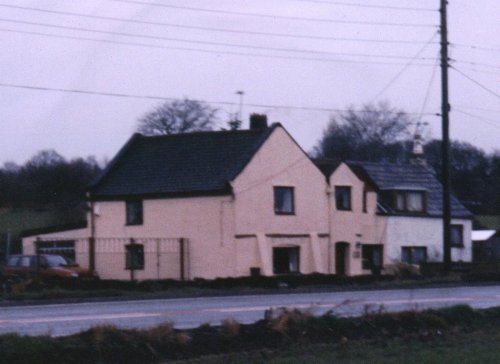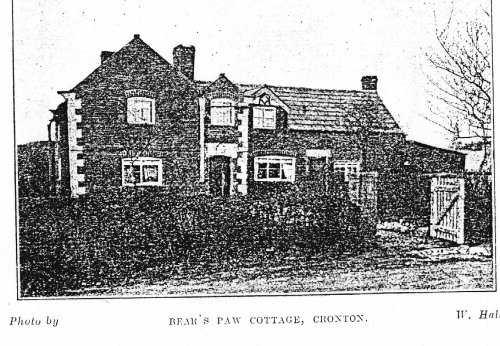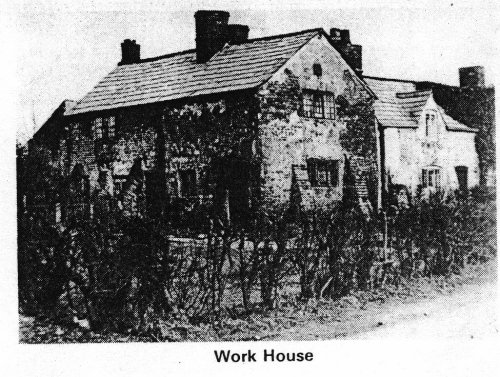 I began this project with the understanding that Cronton, at some time had a Workhouse. Unfortunately this theory was only based on hearsay and presumptions; finding any facts has become a much more difficult task. In fact there appears to have been two Workhouses but all record of the earlier one seems to have disappeared. For this reason it is very difficult to actually prove its existence and therefore my main focus of this assignment shall be on the second Workhouse. Before we look at the evidence it may be of interest to examine the arrangements that were made for the poor prior to the Workhouses being built.
I began this project with the understanding that Cronton, at some time had a Workhouse. Unfortunately this theory was only based on hearsay and presumptions; finding any facts has become a much more difficult task. In fact there appears to have been two Workhouses but all record of the earlier one seems to have disappeared. For this reason it is very difficult to actually prove its existence and therefore my main focus of this assignment shall be on the second Workhouse. Before we look at the evidence it may be of interest to examine the arrangements that were made for the poor prior to the Workhouses being built.
The following piece taken from "The History of Farnworth Church and it's Parish" by Alan Foster gives a brief description of what was provided. "The office of Overseers of the Poor was established in the reign of Queen Elizabeth 1(1558-1603). The statute responsible for their existence provided that every poor person be given sustenance or be provided with work. The Act stated this should be done within each Parish, that is, out of the funds to be raised and applied by Parish authorities within the limits of their respective parishes"
Cronton at this time was still part of the West Derby Hundred under the Parish of Prescot. C. Poole in his book "Old Widnes and its Neighbourhood" believes "that there does not seem to have been any lack of indigent poor in Crouton, and doubtless the same might be said of every other place in the country. "He also goes on to say that "the relief afforded to the poor of Cronton was for a long time outdoor relief in character,a regular Poorhouse not being founded until about the year 1770" Poole is obviously convinced that up to this point there was no Workhouse for the poor of Cronton and that any relief would have been generally outdoor with payment given for any work done to the poor. This theory seems to tie in with what was happening in the rest of the country at that time and must be treated as reliable.
Arthur Whimperley in his book "Widnes through the Ages" does put forward the argument that there was an earlier Poorhouse in Cronton with the following observations.
"In 1716 a Poorhouse or Workhouse was erected and this was located in Cronton Lane (near the present Hill-Crest Hotel). This building has now since been demolished but the evidence suggests that it was used from 1716 until 1779."

Whimperley isn't alone in this theory as the same is mentioned in "the History of Farnworth", which does seem to add weight to the argument but there is no mention of the Poorhouse in the Overseers accounts prior to 1770 which makes a date of 1716 look a little unlikely.
When you examine the accounts listed by Poole further evidence of outdoor relief prior to 1770 is given:
1729 - "To James Rogerson for eight baskets of coal 4s. 0.d.
To Perry's a basket and a half of coals, and to Mary Giddock a basket and an a half ls 9d.
1741.- To nine baskets of coal for Joshua Rigby from Whiston paid at pit. 1s. l0d."
These few extracts from the accounts show that relief to the poor was being given in this way and I believe that had there been a Workhouse in operation at this time, some mention of it would have been made.
One final piece of evidence regarding the existence of an earlier building again comes from Poole. "Sometimes a temporary home was found for a poor person in the family of a cottager, in which case the cost of his board and lodgings and nursing, if necessary, was borne by the overseer. There are two 7 instances of this kind recorded.
1751 - To Thos. Rosson for victuals and lodgings 2 days and nights for Eliz. Pendleton and 4 children 2s.4d.
1758 - To Jane Bradshaw's wife for house room and tenting Catherine Bellion five weeks at 12d. 5s.Od.
These last two dates seem to prove that there was no building for the poor to be housed as early as 1716 but we do get the first mention of the Poorhouse in 1770.
1770- Charges concerning the Poorhouse £6. 12s. 11d.
This gives us our first possible evidence for the existence of the poorhouse in Cronton. In 1779 though the old Workhouse was given up, for what reason we cannot say, and the poor were temporarily housed at Widnes Workhouse. Again we know this from the accounts:
1780- By my journey to Widnes Workhouse to give notice to bring our poor thither 6d.
1780- By cash pd at removing the poor to Widnes Workhouse 1s. 4d.
By cash paid the monthly bill at Widnes Workhouse for the month of April 16s. 6d.
1780.- By cash pd Mr. Hodkinson for writing notices to the tenants to leave the Bear's Paw. .4s.Od.
Both Poole and Whimperley agree on the date and location of the new Workhouse as the Bears Paw cottages which used to be a beer house and still stands in Cronton Lane. This building dates from 1710 and so would back up this argument.
All of the above seems to indicate that for some reason in 1779 the old building was given up and whilst an alternative was made ready the poor were housed at Widnes. The accounts back this up and everything seems to fall into place; that is until you take into account the conflicting argument of G. W. Oxley in his book "Administration of the Poor Law in West Derby Hundred" 1601-1837.

Oxley actually mentions Poole in his book when he writes "References to the Workhouse in the Cronton Overseers Accounts made Poole believe that there was a workhouse in the Township in this period. However, Widnes Workhouse is mentioned in the accounts and its bills, which Poole did not know of show that Cronton as a member of that Workhouse in several if not all of these years." He also goes onto say that "Cronton was a member of Widnes Workhouse in 1776 but mentioned no Workhouse in its returns. Perhaps the policy of each Township claiming the workhouse was decided at a workhouse meeting and the Cronton overseer happened to be absent."
This conflicting view from Oxley obviously throws into doubt the actual existence of a Workhouse in Cronton. Oxley says that certain information wasn't available to Poole, information that isn't available to me now; but Poole had the actual Overseers accounts to hand when he was writing his book and I find it hard to believe that he would have misinterpreted them. Also, Poole wrote the book in 1906 and it stands to reason that he would have been able to speak to local people of an older age to see if they had any recollections about the Poorhouse. Unfortunately the Parish records for Cronton which Poole listed have disappeared (although I have tried to track them down),and so I have been unable to scrutinise them myself but I would like to stick to Poole's interpretation for the following reasons:
1. If there was no original Workhouse in Cronton, then why do the records mention the "old Workhouse"?
2. If there was to be no new Poorhouse in Cronton then why do the records show that notices were served to the Bears Paw cottage for the people there to leave the premises?
It seems to me that Oxley has dismissed the above facts but hasn't really offered any viable argument against their inclusion in the accounts. Oxley also believes that 1779 was the latest date for the Workhouse(wherever it was) to have existed, but there is a clear entry in the accounts which shows in 1829
"Pd. Shandry hire to take her (Esther Plumpton) to Workhouse 3s. 6d."
I find it a bit hard to believe that there was no house for the poor in the area. Even in the 1700's four or five miles would have been a long journey to make to transport the poor to the Widnes workhouse, especially as it has already been established that there wasn't any shortage of poor people in Cronton at that time.
Surely the cost of transport would have forced the local authorities at the time to provide better provision for the poor by housing them nearer to the village, thus reducing the costs?
It is unfortunate, but I cannot end this piece by saying, yes, there definitely was a Workhouse operating in Cronton in 1716 and 1770, there just isn't enough evidence around anymore to back up that sort of statement. What I can say though, is that from the sources I have examined and are available, there is a justified possibility that there was. Without the parish records listed in Poole's book I don't think even this sort of conclusion would have been possible, but it is worth saying that even the overseers records from that time could be interpreted in different ways and an open mind must be kept at all times.
Flnally, I would like to say that, although I haven't been able to prove undoubtedly the existence of the Workhouse at this time, it is an ongoing argument and with the information available to me I am still inclined to believe my original theory that there was a workhouse. Though from what date I cannot be sure.
Phil McGee (Feb 1999)
Bibliography
Poole, C. "Old Widnes and it's Neighbourhood"
Maps
Ordnance Survey 1892
Roberts B.A. The Poor Law Papers of Halewood and Cronton (1976)
(This paper only came to light after Phil McGee had completed his paper).
Foster, A. "The history of Farnworth church and it's village"
Whimperley, A. "Widnes Through the Ages"
Oxley, G.W. "Administration of the Poor Law in West Derby Hundred 1601-1837"
Ordnance Survey 1912
Tithe Map 1840
Footnotes
1. Farnworth parish registers 1700-1837
2. Mrs. M. Jackson (local Cronton historian)
Relief for the poor of Cronton 1601-1834
1601 - Elizabethan Poor Law/overseers of the poor
- mainly outdoor relief
1716 - possible original workhouse in cronton
- continuation of outdoor relief
1770 - first mention of original workhouse
1779 - first workhouse closes (reason unknown)
1780 - poor housed temporarily at Widnes
1780 - new workhouse opens
1829 - last mention of workhouse
1834 - new Poor Laws in the reign of William IV
Prescot Union formed. Cronton poorhouse
dissolved and larger workhouse erected at
Whiston.
Students interested in this subject would also be advised to consult
Dissertation prepared for the Diploma in Local History and held at the Continuing Education Library, University of Liverpool.
